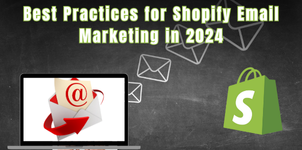Best Practices for Shopify Email Marketing in 2024
Email marketing remains one of the most powerful tools for e-commerce businesses in 2024, and Shopify provides a range of features that allow you to reach your customers effectively. Whether you've completed a Shopify course or participated in Shopify training, mastering email marketing is essential for driving traffic, nurturing customer relationships, and boosting sales.
With constant changes in marketing trends and consumer behavior, it’s important to stay up-to-date with the best practices for Shopify email marketing. This guide outlines actionable steps to enhance your email marketing strategy, from personalization to segmentation and automation, ensuring that your emails stand out in crowded inboxes and deliver results.
1. Personalize Your Emails for Maximum Impact
In 2024, personalization is key to building strong connections with your audience. Sending generic emails is no longer effective. Instead, use customer data to personalize your email content, such as addressing customers by name, recommending products based on their purchase history, or offering location-specific promotions.
If you’ve taken a Shopify course in Lahore or completed a Shopify online course, you’ll already understand the value of personalization. Tools like Klaviyo, integrated with Shopify, make it easy to gather customer data and send targeted emails that resonate with your audience.
2. Automate Your Email Campaigns for Efficiency
Email automation is a game-changer for e-commerce businesses. By automating your email campaigns, you can send timely messages without manual intervention. Shopify supports various email automation workflows, including welcome series, abandoned cart reminders, and post-purchase follow-ups.
For merchants familiar with Shopify dropshipping courses or Shopify courses free, automating emails ensures that you engage with customers at critical touchpoints, boosting sales and improving customer retention. Automated emails have a higher open and click-through rate, making them an essential part of your email strategy.
3. Segment Your Audience for Targeted Campaigns
Segmentation allows you to divide your email list into smaller, more specific groups based on customer behavior, preferences, and demographics. This enables you to create highly relevant campaigns that speak directly to the needs of each segment.
For example, you could segment your audience by geographic location, purchase history, or engagement level. If you've completed a Shopify course in Pakistan or a Shopify full course, you'll know how segmentation increases email engagement and conversion rates.
By sending targeted content to different audience segments, you’re more likely to turn leads into loyal customers. Keywords like Shopify free course, Shopify training, and best Shopify course can be incorporated to appeal to different customer groups based on their shopping behavior.
4. Create Mobile-Optimized Emails
In 2024, more customers are opening their emails on mobile devices than ever before. If your emails aren’t optimized for mobile, you risk losing out on a large portion of your audience. Make sure your email templates are responsive, load quickly, and are easy to navigate on smartphones.
For those who have completed a Shopify dropshipping course or Shopify courses dropshipping, you’ll recognize the importance of mobile-friendly emails for capturing the attention of mobile shoppers. Ensure that your email design includes short, compelling copy, easy-to-click buttons, and visually appealing images.
5. Use A/B Testing to Optimize Campaign Performance
Testing different elements of your emails is essential to understanding what resonates most with your audience. A/B testing (split testing) allows you to compare two versions of an email to see which performs better in terms of open rates, click-through rates, and conversions.
Test subject lines, visuals, call-to-action buttons, and email content. If you’ve taken a Shopify course in Lahore or any advanced Shopify online course, you’ll already be familiar with A/B testing strategies. Using data-driven insights, you can continuously refine your email campaigns to improve their effectiveness.
6. Leverage Shopify’s Built-In Email Marketing Tools
Shopify offers built-in email marketing features that allow you to design and send beautiful emails directly from your dashboard. Whether you’re promoting a new product, running a sale, or announcing holiday promotions, Shopify Email makes it easy to create professional campaigns with customizable templates.
If you’ve completed a Shopify dropshipping course free or any best Shopify course, you’ll know that these tools are particularly useful for small businesses that want to streamline their email marketing efforts without relying on third-party services.
7. Monitor and Analyze Email Performance
Tracking the performance of your email campaigns is essential to understanding their effectiveness. Shopify’s analytics tools provide insights into key metrics such as open rates, click-through rates, and conversion rates.
For merchants who have completed a Shopify course in Pakistan or a Shopify training program, understanding these metrics can help you identify what’s working and what needs improvement. Use this data to fine-tune your email campaigns, ensuring that you’re consistently optimizing your marketing efforts.
8. Build Stronger Relationships with Post-Purchase Emails
One of the most effective ways to retain customers is through post-purchase emails. After a customer makes a purchase, send a thank-you email, ask for feedback, or recommend related products to encourage repeat business.
If you’ve taken a Shopify free course or a Shopify full course, you’ll understand that post-purchase emails not only build stronger relationships but also provide opportunities for cross-selling and upselling.
Conclusion
In 2024, Shopify email marketing continues to evolve, offering more opportunities for personalization, automation, and targeted campaigns. By following these best practices, you can maximize your email marketing efforts, build stronger customer relationships, and drive higher conversions.
Whether you’ve completed a Shopify course or a Shopify dropshipping course, these strategies will help you stay ahead of the competition and achieve better results from your email campaigns.

